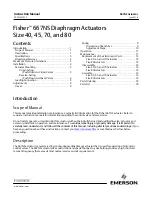
Instruction Manual
D102603X012
667NS Actuator
June 2018
4
D
Maximum Excess Diaphragm Pressure:
Additional pressure may be added when the actuator is at full travel. If the
Maximum Excess Diaphragm Pressure is exceeded, damage to the diaphragm or diaphragm casing might result.
Because the actuator has traveled its specified travel, and the diaphragm head is physically stopped from movement,
the energy from any additional air pressure is transmitted to the diaphragm and diaphragm casings. The amount of air
pressure that can be added once the actuator has traveled to the stops is limited by the resultant adverse effects that
may occur. Exceeding this limiting factor could result in leakage or casing fatigue due to the deformation of the upper
diaphragm casing.
D
Maximum Diaphragm Casing Pressure:
If the Maximum Diaphragm Casing Pressure is exceeded, damage to the
diaphragm, diaphragm casing, or actuator might result. For some actuator sizes, the maximum casing pressure is
the sum of the maximum stroking pressure added to the maximum excess pressure. For other actuator sizes, the
value is lower than the sum of the two pressures.
Installation
The diaphragm actuator is normally shipped mounted on a valve body. Follow the valve body instructions when
installing the control valve in the pipeline.
WARNING
Always wear protective gloves, clothing, and eyewear when performing any installation operations to avoid personal
injury.
Check with your process or safety engineer for any additional measures that must be taken to protect against process
media.
If installing into an existing application, also refer to the WARNING at the beginning of the Maintenance section in this
instruction manual.
If the cover (key 84, figure 4) is not in place on the actuator, install it as shown in figure 4.
WARNING
If the control valve and actuator are installed with the actuator in any position other than vertical, the actuator may not
conform with safety‐related qualifications. Nonvertical orientation should be part of existing qualification analysis on file
at the plant site to ensure conformance with safety‐related qualifications.
The control valve assembly may be installed with any orientation; however, the actuator should not be installed in
ways that allow water to collect in the yoke and actuator spring areas.
Note
The 667NS actuator will not mount on a standard valve bonnet; it requires a style NS bonnet having eight bonnet‐to‐yoke stud
bolts.





































